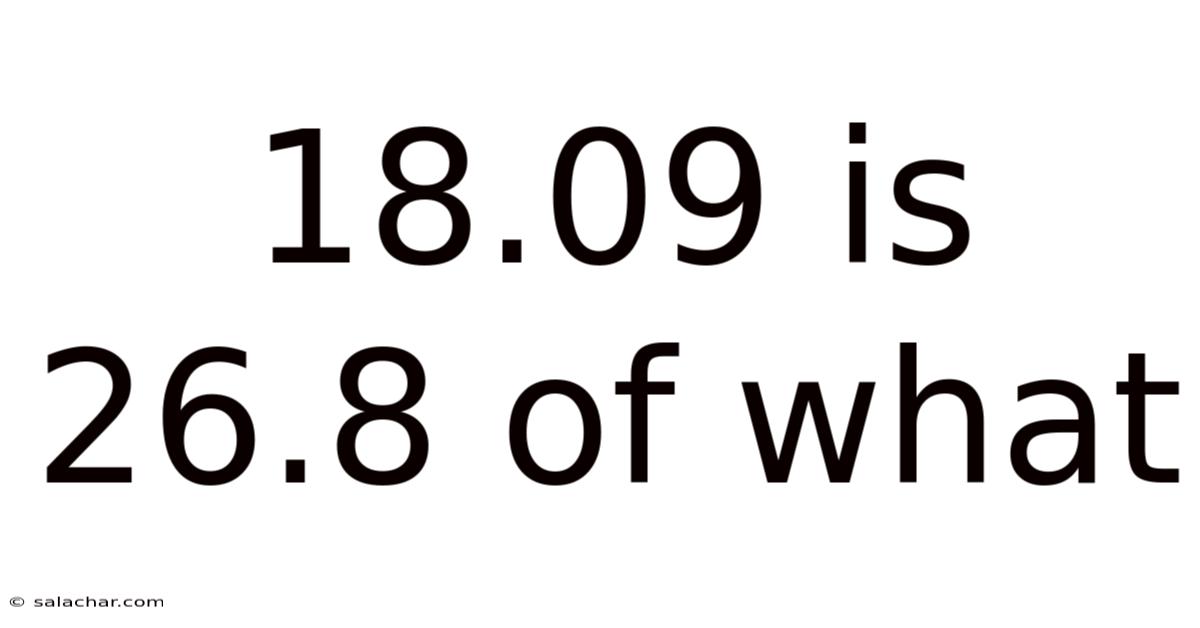18.09 Is 26.8 Of What
salachar
Sep 09, 2025 · 4 min read

Table of Contents
18.09 is 26.8% of What: A Comprehensive Guide to Percentage Calculations
This article will guide you through the process of solving the problem: "18.09 is 26.8% of what?". We'll not only show you how to calculate the answer but also delve into the underlying principles of percentages, providing you with a thorough understanding of this fundamental mathematical concept. This understanding will allow you to confidently tackle similar percentage problems in various contexts, from everyday finances to complex scientific calculations.
Understanding Percentages
Before we dive into the solution, let's establish a solid understanding of percentages. A percentage is simply a fraction expressed as a part of 100. The symbol "%" represents "per hundred" or "out of 100". For example, 50% means 50 out of 100, which is equivalent to the fraction 50/100 or the decimal 0.5.
Understanding this fundamental concept is crucial for solving percentage problems. We can represent a percentage mathematically in three ways:
- Fraction: For example, 25% is equivalent to 25/100, which simplifies to 1/4.
- Decimal: To convert a percentage to a decimal, divide the percentage by 100. For example, 25% is 25/100 = 0.25.
- Percentage: This is the common representation using the "%" symbol.
Solving "18.09 is 26.8% of What?"
Now, let's tackle the specific problem: "18.09 is 26.8% of what?". We can express this problem as an equation:
18.09 = 0.268 * x
Where 'x' represents the unknown number we're trying to find. To solve for 'x', we need to isolate it on one side of the equation. We can do this by dividing both sides of the equation by 0.268:
x = 18.09 / 0.268
Using a calculator, we find:
x ≈ 67.5
Therefore, 18.09 is approximately 26.8% of 67.5.
Step-by-Step Calculation
Let's break down the calculation into clear, manageable steps:
-
Convert the percentage to a decimal: Divide 26.8 by 100 to get 0.268.
-
Set up the equation: Represent the problem as an algebraic equation: 18.09 = 0.268 * x
-
Isolate the variable: Divide both sides of the equation by 0.268 to solve for 'x': x = 18.09 / 0.268
-
Calculate the result: Use a calculator to perform the division: x ≈ 67.5
-
State the answer: 18.09 is approximately 26.8% of 67.5.
Alternative Approach: Using Proportions
Another method to solve percentage problems is using proportions. We can set up a proportion as follows:
18.09 / x = 26.8 / 100
This proportion states that the ratio of 18.09 to the unknown number (x) is equal to the ratio of 26.8 to 100. To solve for x, we can cross-multiply:
18.09 * 100 = 26.8 * x
1809 = 26.8x
Now, divide both sides by 26.8:
x = 1809 / 26.8
x ≈ 67.5
This method yields the same result: 18.09 is approximately 26.8% of 67.5.
Practical Applications of Percentage Calculations
Percentage calculations are incredibly useful in various aspects of life, including:
- Finance: Calculating interest rates, discounts, taxes, tips, and profit margins.
- Science: Expressing experimental results, analyzing data, and calculating concentrations.
- Everyday life: Determining sale prices, calculating tips in restaurants, understanding statistics in news reports.
Frequently Asked Questions (FAQ)
Q1: What if the percentage is more than 100%?
If the percentage is greater than 100%, it means the part is larger than the whole. The calculation remains the same, but the result will be a number greater than the given part. For example, if 200 is 150% of a number, the calculation would be: 200 / 1.5 = 133.33 (approximately).
Q2: How do I handle rounding errors?
Rounding errors can occur due to the limitations of decimal representation. It's essential to use a sufficient number of decimal places during the calculation to minimize these errors. For instance, if you round 0.268 to 0.27, your result will be slightly different.
Q3: Can I use a calculator for these calculations?
Yes, using a calculator is highly recommended, especially for more complex percentage problems. Calculators minimize the chance of calculation errors.
Q4: What if I don't have a calculator readily available?
You can perform the calculation manually, but it might be more time-consuming and prone to errors. Basic multiplication and division skills are required. Long division might be necessary for the division step.
Further Exploration: Advanced Percentage Problems
While this article focused on a basic percentage problem, the principles discussed can be applied to more complex scenarios. You can explore more advanced problems involving:
- Multiple percentages: Calculating successive percentage increases or decreases.
- Compound interest: Understanding how interest is calculated on both the principal and accumulated interest.
- Percentage change: Determining the percentage increase or decrease between two values.
Conclusion
Solving percentage problems, such as "18.09 is 26.8% of what?", requires a clear understanding of percentage principles and a systematic approach to calculation. By converting percentages to decimals, setting up appropriate equations, and using either direct calculation or proportions, you can effectively solve these problems. Remember that practice is key to mastering percentage calculations, and the ability to solve these problems is a valuable skill applicable across numerous fields. The solution, as we’ve shown using several methods, is that 18.09 is approximately 26.8% of 67.5. Understanding the methodology behind this calculation will empower you to tackle a wide range of percentage problems with confidence.
Latest Posts
Latest Posts
-
Green Jungle Fowl For Sale
Sep 10, 2025
-
Toothpaste Is Acid Or Base
Sep 10, 2025
-
Sentence With The Word Are
Sep 10, 2025
-
What Is 5 Of 550
Sep 10, 2025
-
Product Of Sum K Map
Sep 10, 2025
Related Post
Thank you for visiting our website which covers about 18.09 Is 26.8 Of What . We hope the information provided has been useful to you. Feel free to contact us if you have any questions or need further assistance. See you next time and don't miss to bookmark.